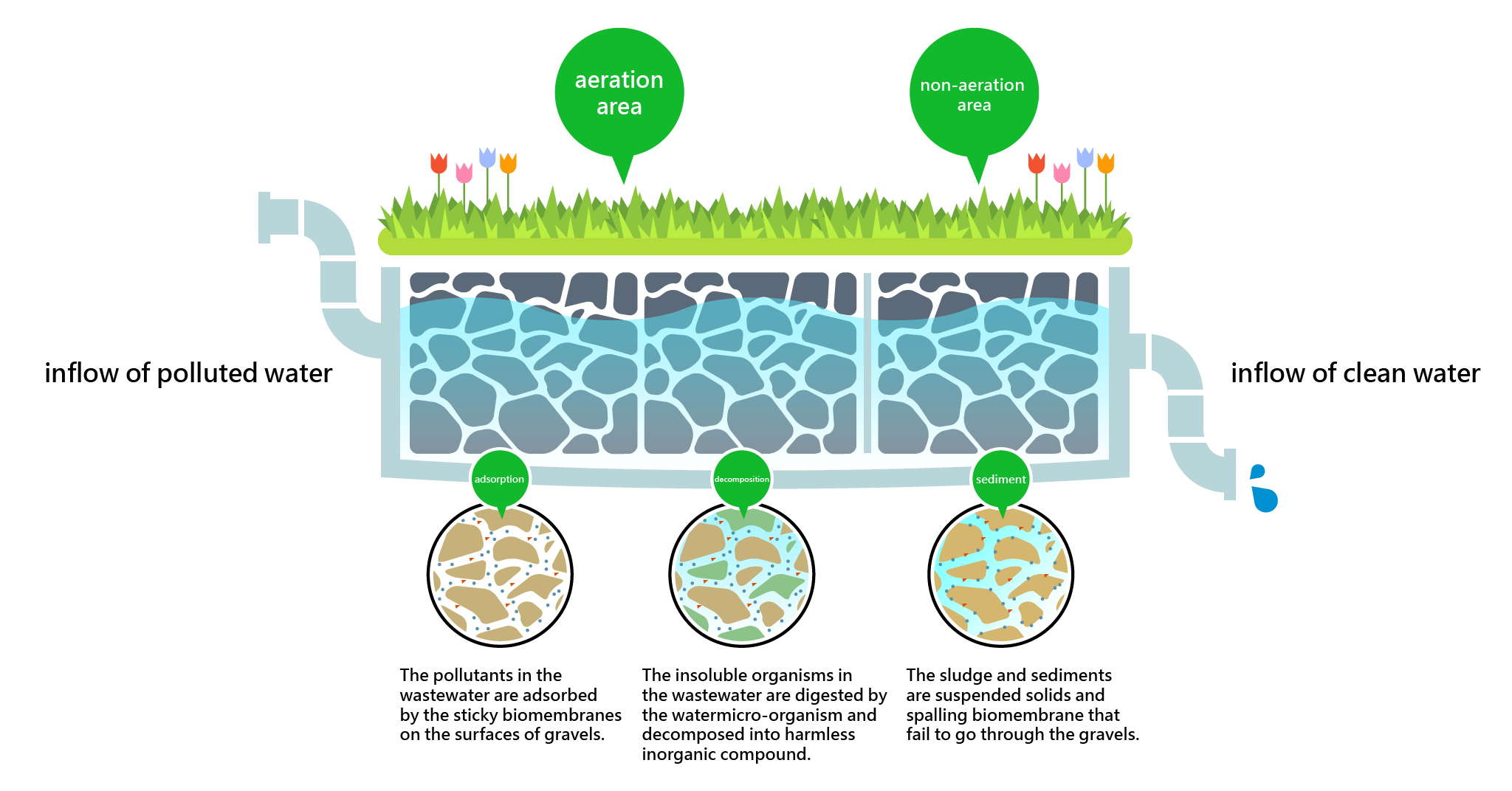On-Site Treatment Facilities
Origin
On-site treatment is the process of treating wastewater near the place where it is discharged, so it doesn't go directly into rivers. This is different from the traditional approach that channels wastewater via the sewer networks to centralized treatment plants.
Given the public’s high expectation and demand on the water quality, the MOENV has taken necessary measures since 2002, “the year of river pollution mediation” to combat pollution. With the assistance of the MOENV, local governments started water purification engineering projects by setting up gravel aeration, constructed wetlands, and community-based wastewater treatment facilities near the pollution sources and the confluence of polluted branch rivers. Through interaction with oxygen, soil, macrobiotics and plants, polluted water was purified, thus reduced the pollutants discharged into the rivers.
 procedure and effects of on-site water purification treatment
procedure and effects of on-site water purification treatment
When wastewater flows into an on-site treatment facility, it goes through aeration area and non-aeration area for absorption, disintegration and sedimentation before treated clean water is discharged. The absorption is to remove the pollutants in wastewater with the absorbing bio-membranes on gravels; the disintegration is to break down the soluble organic matters in wastewater by aquatic microorganisms into harmless inorganic matters; and the sedimentation is the sludge containing suspended solids in water and the bio-membranes peeling off gravels.
Implementation
After the methodologies and techniques from Europe, US and Japan were officially introduced in Taiwan in 2002, on-site treatment projects were implemented at more than 30 locations one after another, including free-flowing surface water and constructed wetland of groundwater, underground infiltration, gravel contact aeration and oxidation, grassed swales and buffer zones, and artificial floating wetlands. These ecological projects of building on-site treatment facilities at the riverfront did not only achieve the goal of water purification. The ecological effects they brought along also gave riverfront a makeover, a new look with more recreational and educational values.
I. Gravel contact aeration
In the 19th century, German scientist Alexander Muller tried channeling wastewater into a pit filled with coal refuse and stones, so that microorganisms would grow on their surfaces and decompose the pollutants in the wastewater. Later, other scientists replaced coal refuse and stones with something bigger, so the water can go through more quickly in order to process larger volume of polluted water. The method was called gravel contact aeration. In the beginning, the sequence of the gravel approach was to channel water in between the gravels, wait for a few hours before discharge, keep the water flowing for 6 days, discharge all the water on the 7th day and allow oxygen to go between the gravels. This procedure is known as the intermittent treatment. In beginning of 20th century, the approach was modified by sending air directly in between the gravels so to process more wastewater more efficiently without the need of intermittent treatment.
Gravel contact aeration/oxidation and intercepting projects in Xinshi Park, Laojie River, two pictures.
II. Constructed wetlands
Constructed wetlands of free-flowing surface water consist of pools, soil and aquatic plants. By interacting with oxygen, soil, microorganisms and plants, polluted water is purified. Among the on-site treatment methodologies, constructed wetlands of free-flowing surface water are the most similar to natural wetlands, so it's also more common at the early stage of wastewater treatment implementation, crowned as “the most beautiful wastewater treatment plants.” A constructed wetland consists of first intensive planting area, open waters, second intensive planting area and an ecological pond.
Dakekan constructed wetland along Dahan River, Taoyuan City, two pictures.
III. Community- based wastewater treatment facilities
nlike the centralized treatment systems for domestic wastewater, a community-based facility doesn't need a complicated sewerage system with many pumping stations and pipeline networks. The technology applied is anaerobic or aerobic treatments. Besides putting lighter burden on local residents, the community-based treatment also entails the following benefits:
- With properly managed and designed on-site treatment, community-based facilities, comparing with a centralized wastewater treatment plant, offer the same efficiency in pollution alleviation but at a lower cost.
- The processed discharge can supplement groundwater (by soil infiltration instead of direct pouring into aquifer).
- The community-based facility can be tailored to the characteristics of the community and doesn't require upfront investment like the centralized plants.
- The community-based facility allows flexibility in choosing the right treatment techniques to achieve the goal of fair use of the land.
Community-based wastewater treatment facility project in the fishing port area of Nanfang'ao. two pictures.
Results
From 2003 to August 20th, 2019, the MOENV has subsidized local governments in setting up 141 on-site pollution control facilities (excluding the on-site treatment projects under the Forward-Looking Infrastructure Development Program) for point source and non-point source pollutions, designed to treat no less than 1.25 million tons of water. The on-site treatment projects across Taiwan improved water quality of the rivers as well as local riverfront and ecological environment. The processed water could be used as distilled water or recharge rivers conveniently to maintain healthy river ecosystems.
At the same time, citizens’ involvement in combating river pollution and the management and maintenance of constructed wetland played an important role in the progress of river pollution alleviation. By visiting the constructed wetlands that purify water, everyone started to own the operational management of on-site facilities, learn through engagement and protect the health of rivers in Taiwan together.